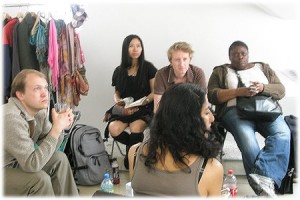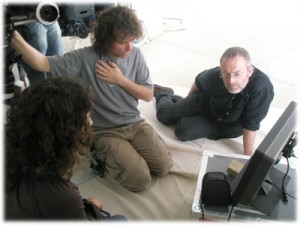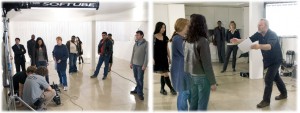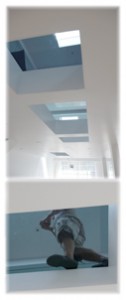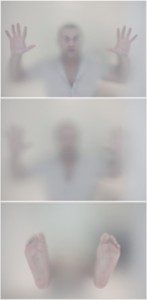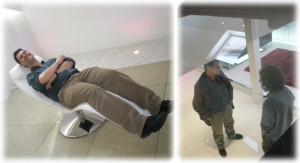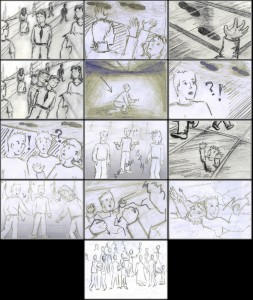If you want to read the English version, click here.
¿A qué conclusión ha llegado el director de fotografía después de haber visitado la localización con el suelo de cristal? ¿Qué opina el experto en infografía acerca de la validez de tal espacio para aplicar luego los efectos visuales? Cualquier decisión que tomemos ahora depende de lo que estos dos miembros del equipo decidan. Una vez más nos encontramos inmovilizados y, teniendo en cuenta el poco tiempo del que disponemos, resulta estresante no poder hacer nada. Lo peor es pensar en la posibilidad de que la conclusión sea que tenemos que volver al plan anterior, olvidarnos de la localización con el suelo de cristal y encargar el plexiglás, porque eso significaría que hemos perdido tiempo del que no disponemos para acabar volviendo al punto de partida.
El día después de la reunión en la que decidimos apostar por la localización, Mark Carey, el director de fotografía, nos envía estas fotos:
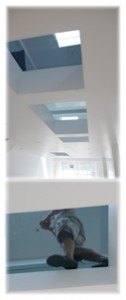
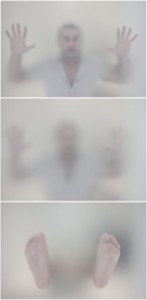
Parece que se ajusta a nuestras necesidades, pero todavía no está todo dicho: la última palabra la tienen los expertos en infografía. Afortunadamente, tras unos días de espera, nos llegan unos vídeos que arrojan un poco de luz sobre el camino a seguir. Se trata de unas previsualizaciones del rodaje en la localización y en el estudio del chroma key. Alan Marques, uno de nuestros infógrafos, ha generado unas simulaciones 3D del rodaje que son infinitamente útiles. Realmente podría decirse que esto atenta contra la esencia del cine como la fotografía digital lo hace contra la analógica. Todas las decisiones creativas se convierten en decisiones técnicas y en previsualizaciones que quitan todo el encanto de la incertidumbre, pero creo que de incertidumbre estamos bien servidos, así que no podemos recibir estos vídeos sino con mucha alegría.
Si quieres compartir esta alegría, puedes descargarte los vídeos aquí:
Previs on location 1
Previs on location 2
Previs on studio 1
Previs on studio 2
O verlos online en nuestra web.
Gracias a esto sabemos qué tipo de objetivo necesitaremos, la distancia y ángulos desde los que deberemos filmar… prácticamente sabemos incluso cuánto deberían medir nuestros actores.
Ahora sí, por fin, podemos decir que todo está en marcha DE VERDAD.
Por fin podemos avanzar, y todos sabemos que ahora es cuando todo se acelerará, pero con calma y organización esto no tiene porqué acabar en tragedia. Ya sabemos qué cámara nos hará falta: la Red One; qué lentes e iluminación necesitaremos; qué otros accesorios tenemos que conseguir, como una pieza de tela negra, otra verde, una cuerda verde, un papel adhesivo que proporcione al cristal un aspecto empañado…
Por otra parte, ha llegado un momento que hemos temido desde la última reunión: tenemos que hablar con el dueño de la localización. Todos estamos muy entusiasmados con la posibilidad de rodar allí el vídeo, pero… ¿y si a él no le emociona tanto la idea? ¿Qué pasa si no está de acuerdo con que más de veinte personas se hagan con su casa y la llenen de cámaras, luces, comida…? (sí, al fin y al cabo será un largo día de trabajo y todos necesitamos comer en algún momento).
Visitamos la localización con la mejor de nuestras sonrisas y prometiendo ser buenos. Tomamos medidas, barajamos distintas opciones respecto a ángulos y objetivos… y lidiamos con el dueño del lugar. Se trata de un tema particularmente delicado porque de hecho esta localización es su casa, y ha tenido malas experiencias pasadas con grandes equipos de producción, por lo que siempre prefiere ceder su espacio a pequeños equipos de fotografía. Se trata, sobre todo, de una cuestión de respeto de cara a sus vecinos. No hay problema, accede a nuestra petición y nos informa además de cómo podemos organizar el catering para el día del rodaje. Las cosas no podrían ir mejor. ¿O sí?

Mark Carey, (director de fotografía), Mark Saunders (productor), Dave Barnard (infografista) y Karim (dueño de la localización) trabajando
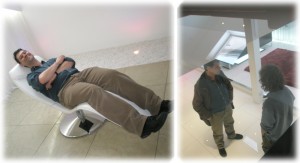
Dave Barnard, relajándose un poco, y discutiendo el rodaje con Mark Carey bajo el Techo de Cristal
De repente nuestras expresiones se hielan. El 1er asistente de cámara llama diciendo que le han ofrecido un trabajo de tres días en Italia. Nosotros sólo le ofrecemos trabajo para dos días. Mark, el director de fotografía, nos suplica que encontremos una solución a este problema, incluso que pospongamos el rodaje. No, no es posible. Ya hemos contactado con los actores, con el Consejo de Europa, con el otro estudio. Mark confía ciegamente en este 1er asistente de cámara y considera imprescindible su colaboración en este proyecto. Usaremos una tecnología muy nueva y sólo se siente seguro si trabaja con él, ya que pocas personas conocen estos equipos. Una vez más se demuestra cuánta gente realmente imprescindible hay detrás de los vídeos, cuando realmente la cara que vemos es tan sólo la de unos pocos actores.
Para obtener más información acerca del proyecto “Speak out against discrimination”, pincha aquí.
Para obtener más información acerca de Spectacle, pincha aquí.

